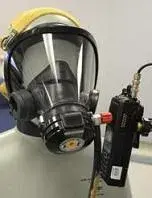 (February 25, 2009) To improve firefighters’ radios, recording garbled speech is the first step toward clearing it up.
(February 25, 2009) To improve firefighters’ radios, recording garbled speech is the first step toward clearing it up.
If you’ve ever been on the other end of the line, straining to hear a friend shout over a fire truck’s horn as it races by, take solace: You could be the firefighter. From screaming sirens to roaring blazes to whooshing oxygen masks, firefighters regularly work amidst background noises that muddle conversations over their trusty two-way radios.
In 2006, firefighters began anecdotally reporting unintelligible conversations during emergency response. The audio quality from newer digital radios seemed inferior to the quality of older analog radios. But without a carefully documented collection of garbled communications, both sides could not be sure the problem wasn’t old fashioned user error. And without identifying the exact causes of distortion, manufacturers could not begin to look for potential fixes.
Enter the Digital Radio Vocoder Testing project, sponsored by the U.S. Department of Homeland Security’s Science and Technology Directorate (S&T). The cause of audio distortion stems from a digital radio component called the vocoder, which converts a voice into a digital signal and then back to an audio sound. When background noise is loud, the vocoder may make radio conversations completely unintelligible, putting firefighting teams and people trapped inside burning buildings at risk.
S&T’s Command, Control and Interoperability (CCI) Division and the Office for Emergency Communication in the DHS National Protection and Programs Directorate are working with are variety of groups to understand how background noise affects voice communications, and to determine what technology improvements are needed to overcome background noise issues.
Groups include the International Association of Fire Chiefs (IAFC), the National Institute of Standards and Technology (NIST), manufacturers, scientists, and fire service leaders,
“We’re providing firefighters with the scientific evidence behind their claims that they are having problems in the field, and showing that this is an issue with their radio equipment,” said Luke Berndt, DHS Chief Technology Officer for the Office of Interoperability and Compatibility in CCI.
Not all firefighters’ conversations are unintelligible; but when lives are at stake, you don’t want important information to be garbled.
“It may occur in only 5 percent of scenarios,” said Berndt, “but it is vital in those moments.”
To figure out when firefighters could and couldn’t hear each other, audio engineers had to bring the sounds of an emergency into a controlled laboratory setting.
To do this, they measured and recorded the actual environments in which firefighters work. This included riding in or standing near cars and trucks with and without sirens; wearing and using equipment like breathing masks, chainsaws, pumps, and circular saws; communicating over special alarms that indicate when a colleague is in trouble or when one’s own air tank is low.
Engineers piped the recordings into a studio in Boulder, Colorado, where a hi-tech firefighter mannequin stood with a radio. The radio transmitted the sounds to another firefighter mannequin and radio in a separate studio, giving engineers the opportunity to analyze the quality of the radio transmissions and change the type of radio to test for improvements.
“There was a measurable difference in the analog versus digital intelligibility,” said DJ Atkinson, lead electronics engineer at Institute for Telecommunication Sciences who oversaw the vocoder testing. Firefighters had the most difficulty communicating through breathing masks and when their personal alarms went off, said Atkinson.
Listen to Vocoder Examples
- Radios operating in a quiet environment (MP3 - 8 seconds, 131KB)
- Radios operating through a mask in a quiet environment (MP3 - 8 seconds, 129KB)
- Radios operating in a mask with an alarm going off (MP3 - 8 seconds, 129KB)
File one is a radio operating in a quiet environment. File two is a radio operating through a mask in a quiet environment. File three is a radio operating in a mask with an alarm going off. The transcript for each sound file is the same: Please select the word went. Please select the word sent. Please select the word bent. Please select the word dent.
Now that radio manufactures have recognized that a problem exists, exploring possible technological solutions is the next step. One possibility is to improve noise-cancelling technology, similar to the kind found in headphones, and put it into microphones. Noise cancelling technology already exists for dampening specific types of noises, such as a broad noise like an airplane engine, or a sharp noise like a police siren.
“What firefighters need instead is technology that is very general, that can address a number of types of noises,” such as a siren and a blasting water hose, said Atkinson.
Another option is to outfit a firefighter’s helmet with a bone-conducting microphone that picks up small vibrations through a person’s head as she talks.
“(Vocoder testing) is one of the more rewarding projects I’ve worked on,” said Atkinson, who has worked on audio quality issues for more than 20 years. “It’s something that can actually make a difference, something that may save a life at some point. Many people don’t get to work on projects like that during their careers.”
To request more information about this story, please e-mail st.snapshots@hq.dhs.gov.
